Frozen in Time (21 page)

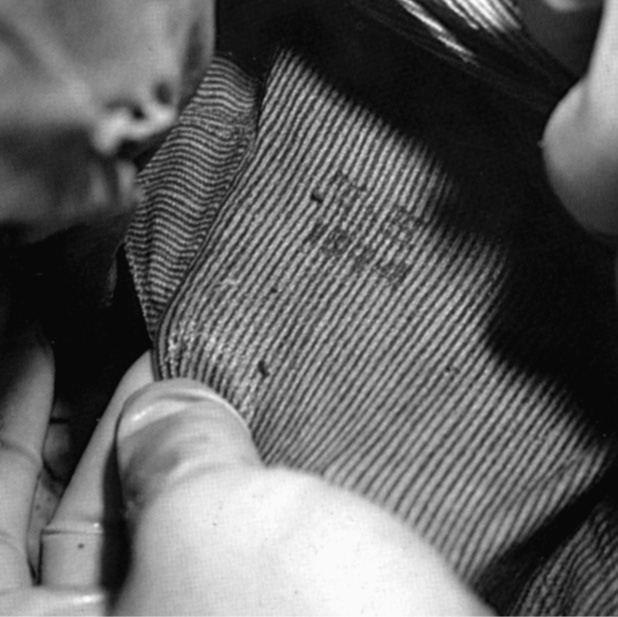
The bottom of Hartnell's shirt was embroidered with the date 1844 and the initials “th,” suggesting that the shirt may have belonged to his brother, Thomas.
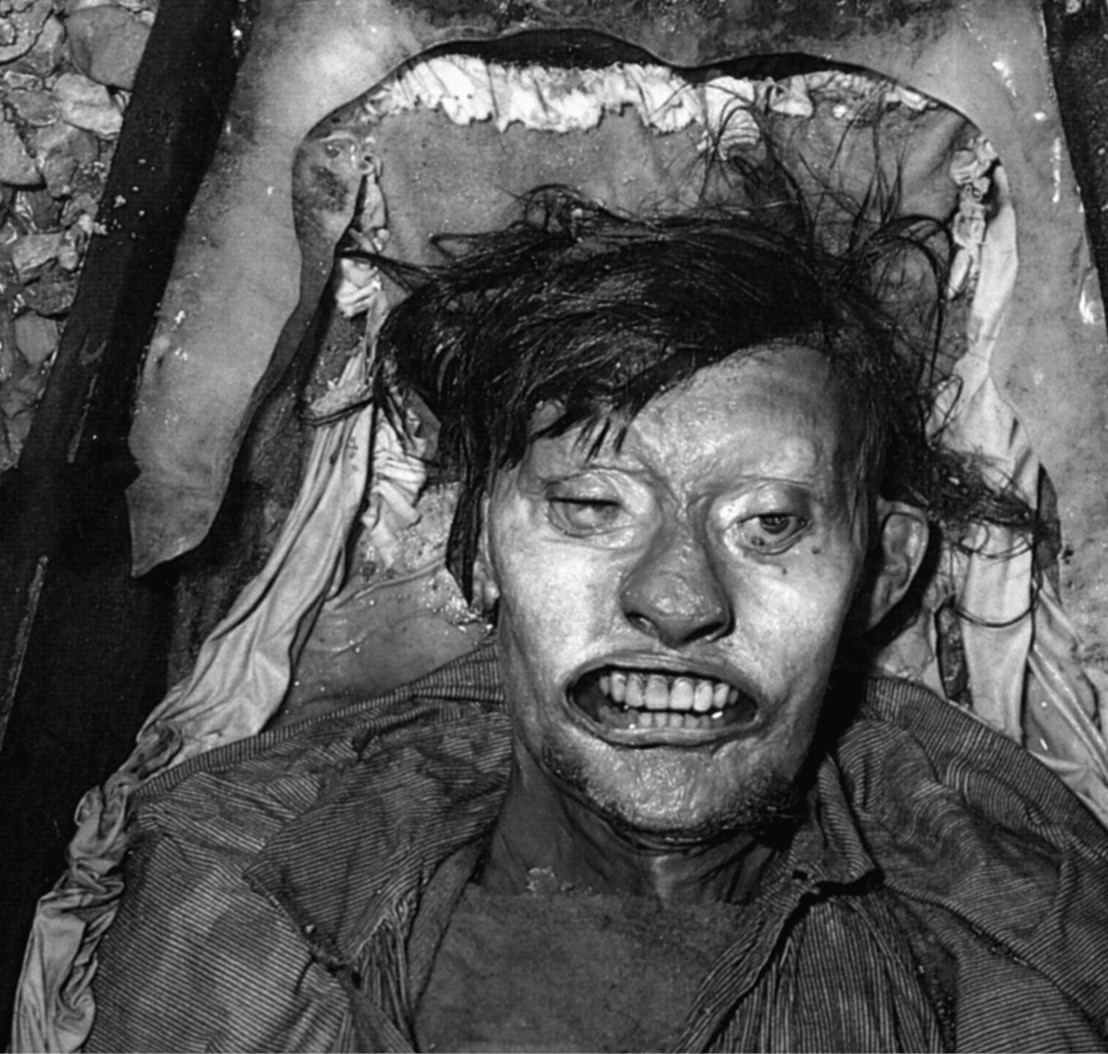
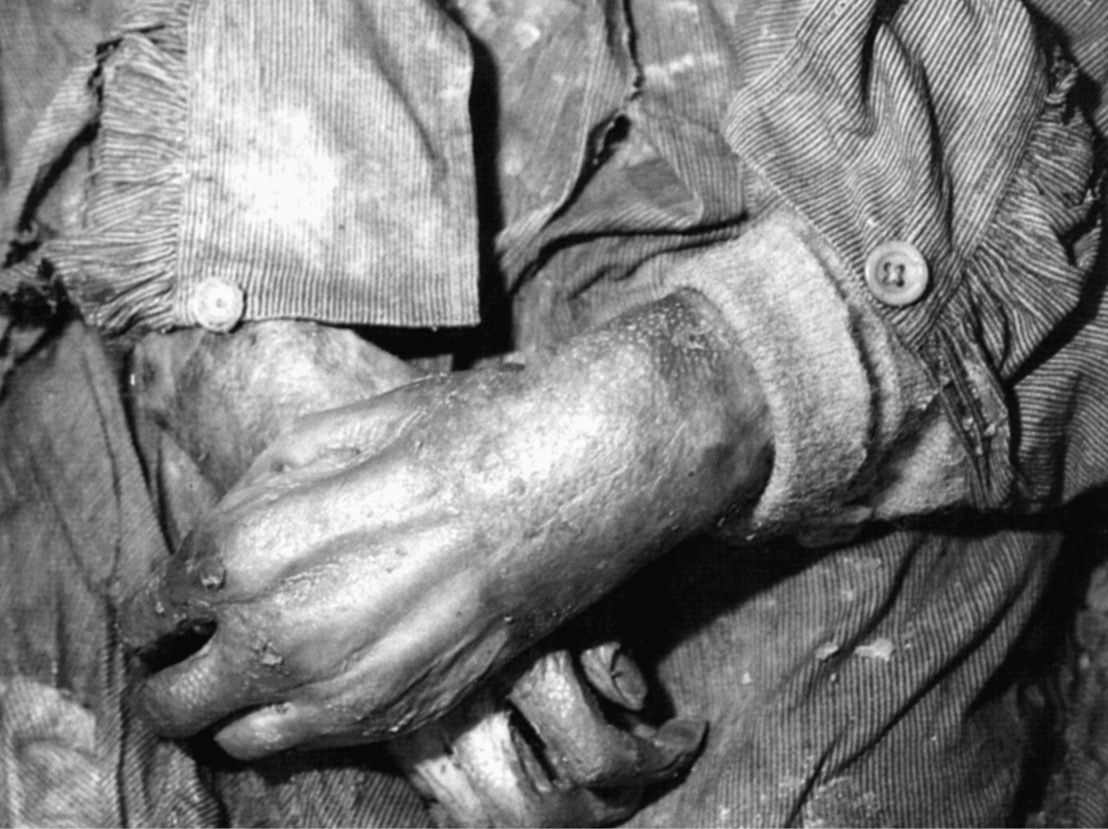
Hartnell's legs and feet were slightly darkened and very shrunken and emaciated by illness and in part by the freezing. Like Torrington, his toes were tied together. In preparation for the temporary removal of Hartnell's body for the X-ray examination and autopsy, the shroud was completely pulled back and Hartnell's cap removed, revealing a full head of very dark brown, nearly black, hair, parted on his left. Without his hat, Hartnell lost much of the sinister look that ï¬rst confronted the scientists in the summer of 1984. Instead, he appeared to be simply a young man who, for some mysterious reason, had died at the age of twenty-ï¬ve on 4 January 1846.
Now began the most difficult and unpleasant phase of the exposure. Even as Hartnell lay in the coffin, apparently ready to be gently lifted out, his body was still part of the permafrost, solidly frozen to the mass of ice below. Slowly and carefully, water had to be directed underneath the body, freeing it a fraction of an inch at a time. The permafrost had a grip that would not let go without a ï¬ght. But ï¬nally, the scientists won the battle and the body was freed.
Before lifting Hartnell from his coffin, his right thumbnail was removed and samples of hair from his scalp, beard and pubic area were collected for later examination and analysis. Beattie, Carlson, and Nungaq then lifted the body out of the grave onto a white linen sheet, where it was immediately wrapped. Hartnell was carried a distance of 10 feet (3 metres) to the autopsy/X-ray tent, where Notman and Anderson prepared to take a series of X-rays while he was clothed. Still frozen to the bottom of the coffin were Hartnell's nineteenth-century shroud, and beneath that, a folded woollen blanket. Damkjar, over the next day, struggled to remove these two items. When they were ï¬nally freed, they were handed over to Schweger for analysis and sampling.
Notman and Anderson had already set up their X-ray “clinic” inside the autopsy tent. The next order of business was the assembly of the darkroom tent. Beattie had provided them with the inside dimensions of the long-house tent months before and, using these, they had designed a unique, collapsible and portable darkroom. The structure consisted of a tubular metal frame that was screwed together; over this, a double layer of thick black plastic (cut, formed and taped together) was pulled and tucked in along the ï¬oor. On one side they had fashioned a door from a double overlap of the plastic cover, forming a light trap. Inside the darkroom, Anderson had just enough room to stand and manoeuvre around the chemical tubs. A mechanical timer was hung inside as well as a battery-operated safe light.
Kowal gave them a hand in melting the 110 gallons (500 litres) of clean, strained water required for the X-ray ï¬lm development. Four large Coleman stoves were running in the tent constantly, and Kowal would bring in buckets of snow to melt. When a bucket was ready it was poured through a ï¬ne strainer directly into the large plastic garbage bins they had brought as chemical holders. When the tubs were ï¬nally ï¬lled with water (which took a whole day), Anderson mixed his chemicals. He then made wood-framed structures to hold the ï¬lm sheets in their development frames, and these were lowered into the tubs. A 200-watt aquarium heater was then immersed in the liquid, which would bring the temperature up to the 68ËF (20ËC) thought necessary to provide controlled development.
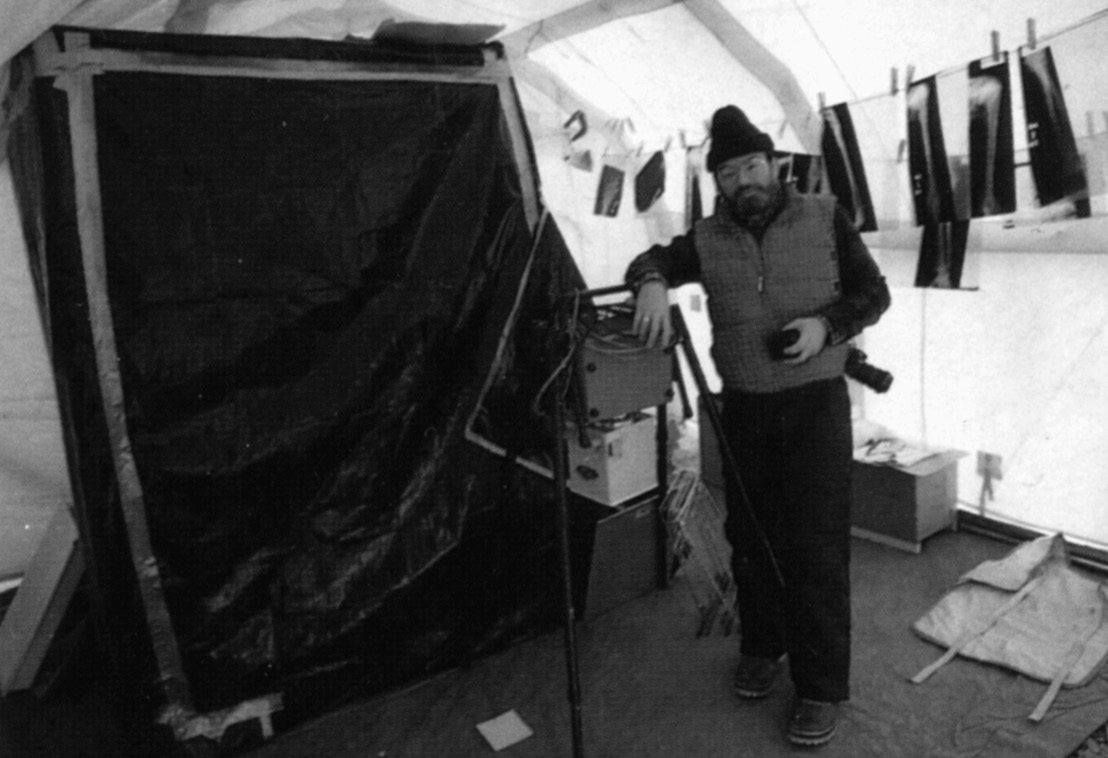
Larry Anderson in the autopsy/X-ray tent. He is leaning on the portable X-ray unit; the black structure is a portable darkroom.
The X-ray unit was a remarkably compact yet powerful instrument mounted on four tubular steel legs. Too fragile to risk being sent from their clinic at the Park Nicollet Medical Centre in Minneapolis as normal freight, Notman and Anderson had bought an airplane ticket for it, and everyone had a good laugh when they told how the machine, named Fragile Bulky Notman on its ticket, had “sat” in the ï¬rst-class section at the front of the plane during the ï¬ight into Canada while they had to sit back in economy class.
When in use, the machine would be lifted over the body, its legs positioned ï¬rmly in the gravel. A focusing light beam on the bottom of the unit would then be turned on to illuminate and deï¬ne the area to be X-rayed before a ï¬lm plate was slid under the body.
Notman and Anderson tested their X-ray set-up on a polar bear scapula, found lying on one of the beach ridges near the gravesite. The results were very encouraging: holding the X-ray up, Notman described the bony details of the scapula to the others. Although they had been told by a number of experts that they were not likely to succeed in getting satisfactory X-rays under such difficult ï¬eld conditions, his voice betrayed a note of gleeful triumph and self-satisfaction. Anderson's face also seemed to say, “Well, they were all wrong! I knew we could do it!”
With this air of success, Notman and Anderson began the difficult job of X-raying the clothed John Hartnell. The X-ray area on the ground adjacent to the door was the same as where the autopsy was to be performed. When an exposure was to be made, either Notman or Anderson would put on a heavy, full-length lead apron and all other people in the tent would line up behind their protector. A loud call of “exposing” would be made for the beneï¬t of people working outside the tent, so that they could move away to a distance of at least 100 feet (30 metres) before the exposure was made.
Anderson would then take the ï¬lm plate into the darkroom for processing. Ten to ï¬fteen minutes later he would emerge with the dripping ï¬lm, which he hung by pegs to clotheslines stretched across the length of the tent. He and Notman would then examine the quality of the ï¬lm and decide if there was any need to change their technique.
When the initial X-raying of Hartnell had been completed, Notman, Anderson and Amy stood in front of the row of hanging ï¬lm to begin the preliminary examination. Anderson quickly pointed to the ï¬rst X-ray: “He's got a solid block of ice in his head.” The frozen brain tissue obscured the X-ray image, meaning they'd have to X-ray again after further thawing. Looking at the chest X-rays, Notman pointed to a small feature near Hartnell's neck. “We've got our ï¬rst metallic object,” he said. “It looks like a ring on its side.” (In fact, the metal was the frame of a decorative, embroidered button.) The chest X-rays were also confusing in that the internal organs appeared uncharacteristic and of unusual and varied densitiesâan unexpected series of observations on the ï¬rst X-rays ever to be taken under such circumstances.
The bone structure was largely unremarkable, with the exception of a suspected compression fracture of one of the vertebrae in the lower part of the neck, representing a subacute injury that would not have been fatal. Hartnell may have fallen on the expedition. Some degenerative bone changes were also identiï¬able in the left shoulder and left elbow; found in someone so young, these sorts of bone changes (spurring and lipping) usually indicate a response to some form of injury. Also, one of the small long bones of the left foot showed evidence of osteomyelitis, or a bone infection, which could have made Hartnell susceptible to systemic infections (blood poisoning). Any of these injuries or conditions could have resulted in Hartnell being conï¬ned to sick bay, where he would have been given tinned foods as a medical comfort.
However, except for the details of the bones, little could be determined, let alone identiï¬ed, from these ï¬rst X-rays. Beattie wondered if the soft tissue preservation, which appeared so good to the eye, was in fact not good enough to allow X-ray information to be collected. Notman was frustrated with these ï¬rst ï¬ndings for, even in the desiccated and eviscerated Egyptian mummies he had studied in the past, there had always been some recognizable details in his X-rays. Only the autopsy would provide the answers.
It had been difficult to position the body with the clothing still on, and, spurred on by the confusing results of the ï¬rst X-rays, Notman and Anderson wanted to try again after the clothing had been removed. Beattie, Amy, Nungaq and Schweger began the difficult task of unclothing Hartnell. “What we'll do is ask the patient to sit up,” Amy said, a request for Beattie and Schweger to support the body while he attempted to remove the outer shirt. Trained in the medical ï¬eld, Amy, Notman and Anderson always referred to the sailors as patients, reï¬ecting their strictly professional attitude towards medical procedures and research, even in these extraordinary circumstances. After some initial attempts to slip the clothes over Hartnell's head and off his limbs, it was decided that it would be necessary to cut the fabric. To minimize damage to the clothes, Beattie made a single vertical cut up the back of each garment. Doing this avoided the over-extension of the limbs and prevented any stress being placed on the material, which could have caused tearing both in the fabric and along the seams.
As the clothes slipped off the body the scientists made a truly astonishing discovery.
“Son of a bitch, he's already been autopsied! Son of a gun!” said Amy. “We've got an upside down âY' incision. This sort of thing has not been seen before, this is absolutely unique.”
Running down John Hartnell's chest and abdomen was a sutured incision that left no doubt that, in the short hours after his death, a surgeon on the
Erebus,
probably assistant-surgeon Dr. Harry D.S. Goodsir, an anatomist by training, had attempted to establish the cause of death. It's no wonder Amy was so excited at this discovery. Here he had an unprecedented opportunity to view the handiwork of a medical predecessor of long ago. By conducting his own autopsy, Amy would actually be assisting this long-dead doctor. The surgeon of the
Erebus
certainly anticipated that he would bring the information from his autopsy back to England. Now the full extent of that information would ï¬nally be known.
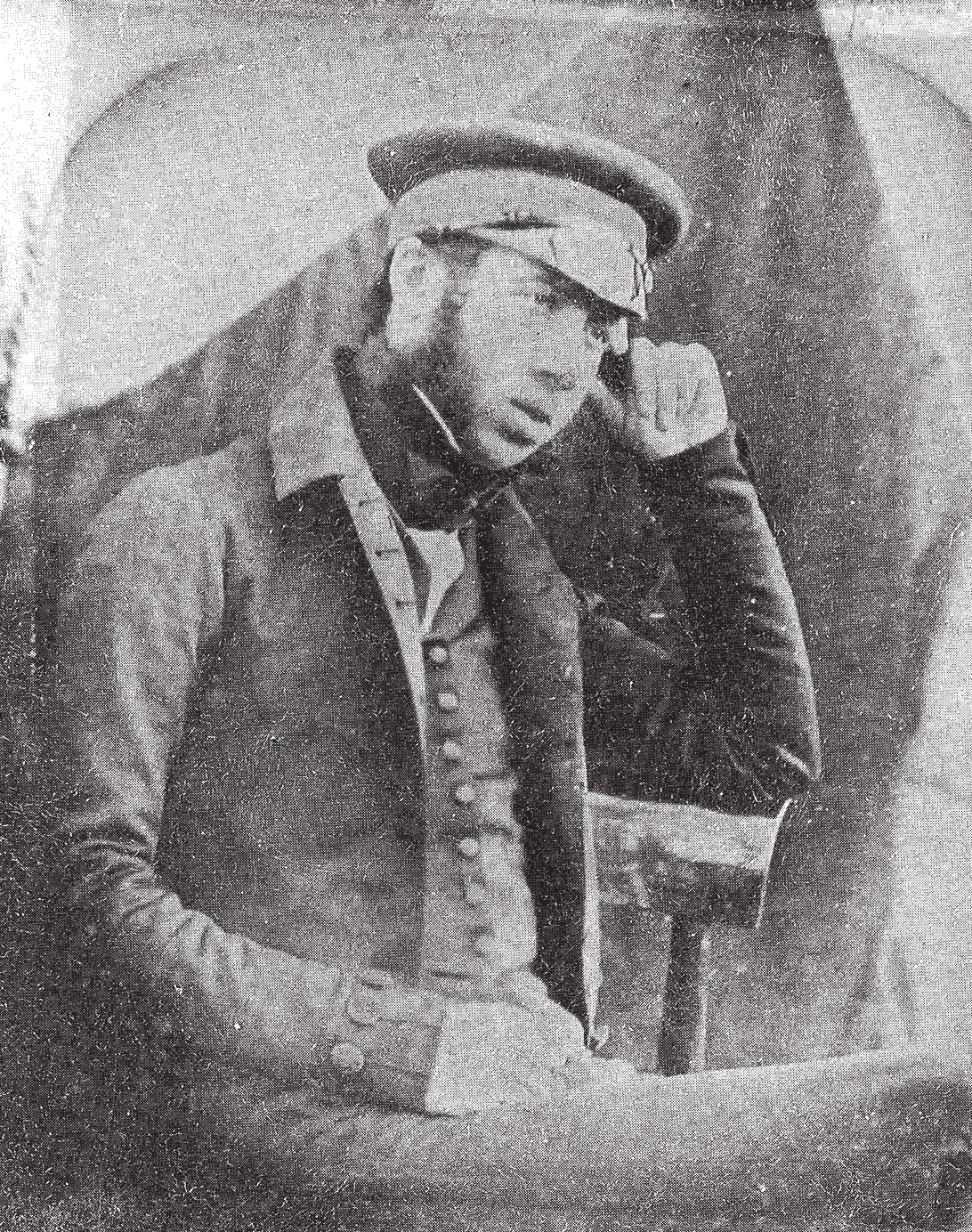
Dr. Harry D.S. Goodsir.